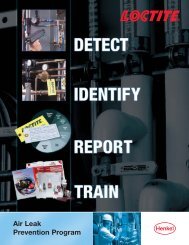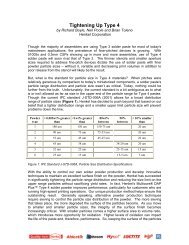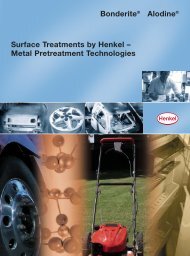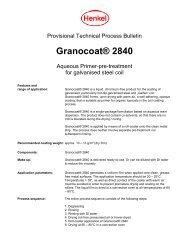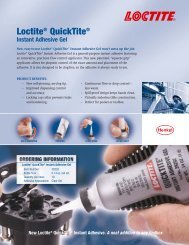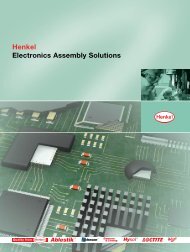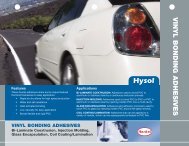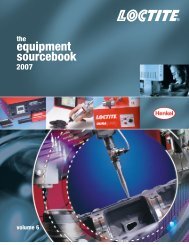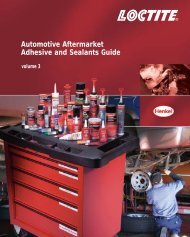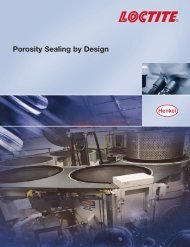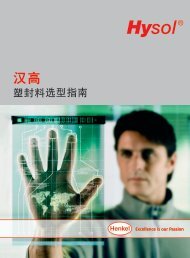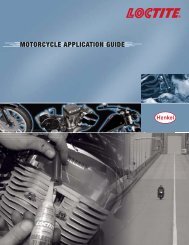SOUND ENGINEERING FROM - Loctite.ph
SOUND ENGINEERING FROM - Loctite.ph
SOUND ENGINEERING FROM - Loctite.ph
- No tags were found...
Create successful ePaper yourself
Turn your PDF publications into a flip-book with our unique Google optimized e-Paper software.
Assembling Speakers with <strong>Loctite</strong> ® AdhesivesPole Piece to Magnet to Top PlateThe three essential components bonded in the magnetassembly are the magnet itself (most commonlyceramic ferrite rings) and either a T-yoke, whichincludes a pole piece, or a plate and pole combination,and a top plate, or washer, made of steel. The T-yoke(referred to as the back plate, end plate or pole andplate) is bonded onto one face of the magnet, and thetop plate (referred to as the washer or front plate) isbonded to the other face.To achieve consistent bonding performance, matingsurfaces must be clean. Steel parts may be contaminatedwith plating residues, or lubricants, and the natureof the problem varies with the production process. Aby-product of the Blanchard grinding process thatmakes magnet faces smooth and parallel, is a coating offine dust which should be cleaned from the matingsurface before bonding, using a damp cloth. If any otherresidues are suspected, the mating surfaces of the partsshould be cleaned with isopropyl alcohol or acetone.Bonding the magnet assembly together is oftenaccomplished with two-part epoxy adhesives, especiallyin Asia, where the adhesive is widely known as"A/B glue". When mixed properly at a 1:1 ratio, the resultingadhesive is typically gray. A combination of poor orabsent mixing technique (running two beads over eachother), and assembly line workers failing to rotate theparts while pressing them together, is a recipe for disaster.This approach requires that the operator dispensethe correct ratio by eye, which may be difficult withcomponents of differing viscosities. An emerging trend isthe use of static mix nozzles or equipment to obtaina more consistent, reliable method.Cyanoacrylates have been used for magnet and steelassembly in small and specialized drivers, and althoughthey can be very fast, their long term bond strengthto ceramic materials remains questionable. The successof the method suggests that in low stress applications,a rubber toughened cyanoacrylate may provide thedesired performance. Occasionally, cyanoacrylatesare used to tack parts together quickly, in combinationwith structural acrylics to insure the needed long termdurability.Current thinking on magnet to steel bonding runsin favor of structural acrylic adhesives, with severalvariations formulated for different surfaces, gap fillcapability and fixture times. These structural adhesivesare economical, fast, strong, easily dispensed, and createthin bondlines to minimize magnetic energy losses.<strong>Loctite</strong> ® structural acrylics develop good handlingstrength in 30 to 90 seconds, which allows the magnetassembly to be magnetized within 5 minutes of assembly.This speed of fixture also allows the magnetassembly to be placed briefly into a clamp, where it canbe pressed to create a very thin and uniform bondline.This extra step can be beneficial in high performancedrivers and compression drivers, where tolerances mustbe very tight. Structural acrylics are used with primers,and the latest solventless primers for dichromatedsurfaces can bond to steel that has been dichromated,or plated with clear, black or yellow zinc.8



